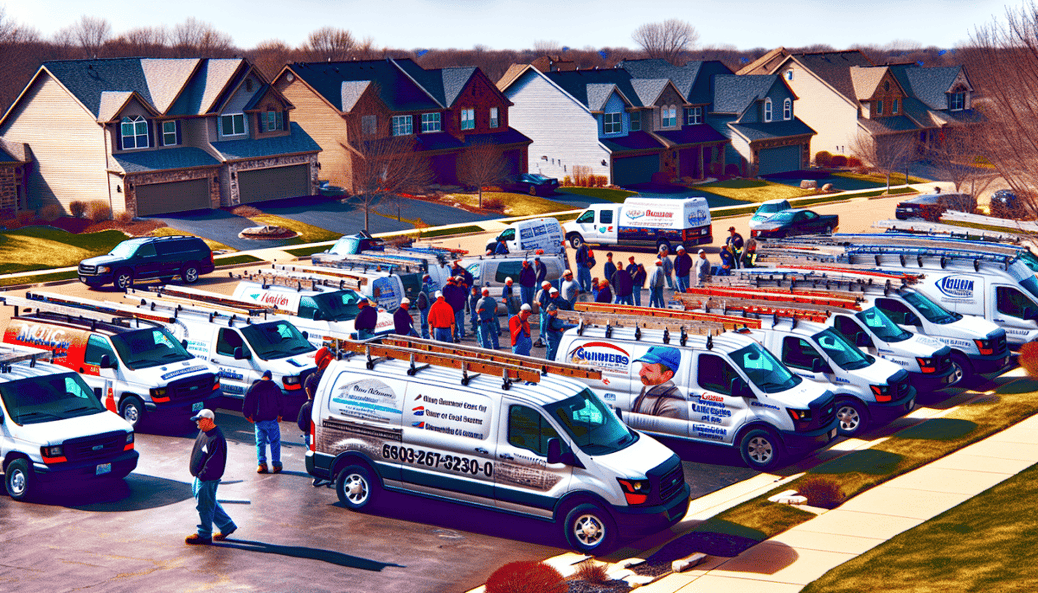
Understanding Roofing Lead Costs: How Much Does A Roofing Lead Cost in 2024?
Listen to the article
Understanding Roofing Lead Costs: How Much Does A Roofing Lead Cost in 2024?
If you’re pinpointing “how much does a roofing lead cost” for your business, you’re looking at a range between $200 and $500. This broad spectrum takes into account the variables such as lead quality, exclusivity, source, and market-specific dynamics. In this article, we break down these elements, offering a clear view of what affects the question of how much does a roofing lead cost and how you can navigate these expenses effectively.
Key Takeaways
- The value of roofing leads varies significantly based on factors such as lead types (exclusive vs. shared), lead sources (organic, paid ads, online directories), lead quality, and the potential lifetime value of the customer, with prices ranging from $200 to $500.
- Factors like competition and market saturation, geographic location and local demand, as well as seasonality and weather conditions, significantly affect the cost of roofing leads, necessitating region and market-specific strategies.
- To reduce the costs associated with roofing leads, businesses should invest in SEO, utilize social media and content marketing, focus on customer retention and referrals, and continually measure and analyze lead generation performance to adjust strategies for improved ROI.
Determining the Value of Roofing Leads

The value of a lead in the roofing industry is not a one-size-fits-all number. Different types of roofing leads can provide different kinds of customers and results. A lead’s worth can range anywhere from $200 to $500, underlining the need for roofing companies to optimize their lead acquisition costs. It’s not just about how much you pay for a lead, it’s about what you get in return.
The value of a lead is shaped by various factors which are integral to an effective lead acquisition strategy. These factors encompass the types and sources of leads, lead quality, and the potential value of the customer. We’ll examine each of these factors further.
Lead Types: Exclusive vs. Shared
When it comes to lead types, we primarily deal with exclusive and shared leads. Each has its own advantages and drawbacks, primarily in terms of cost and conversion potential. Exclusive leads are sold to only one roofing contractor, making them more expensive but offering a higher close rate. On the other hand, shared leads are sold to multiple roofing companies at a lower cost, but with less chance of closing the job due to increased competition.
Yet, cost isn’t the sole determinant. The value of a lead is significantly influenced by its quality. Exclusive leads are more valuable due to a higher quality of prospect with real buying intent, leading to a higher return on investment (ROI) despite their higher initial cost. In contrast, shared leads often result in decreased profitability due to bidding wars among contractors, ultimately decreasing the lifetime value obtained from each lead.
Lead Sources: Organic, Paid Ads, and Directories
The origin of a lead also plays a significant role in determining its cost and value. In the digital age, the primary sources of leads include organic search, paid advertising, and online directories. Each of these sources comes with its own set of advantages and disadvantages in terms of cost and effectiveness.
Organic search leads, for instance, are considered the most affordable and can help roofers produce exclusive leads for free, serving as a cost-effective long-term strategy that builds trust and credibility with potential customers. On the other hand, paid search advertising provides immediate visibility and targeted traffic, but it requires ongoing investment and can become expensive due to keyword competitiveness.
Lastly, online directories may produce low quality leads that may have a lower likelihood of conversion, leading to mixed reviews from businesses and an increase in irrelevant phone calls.
Quality of Leads: High-Quality vs. Low-Quality
In the context of leads, quality invariably takes precedence over quantity. High-quality leads display strong buying intent and are usually acquired by contractors who cater to this intent through personalized marketing communication. These leads result in increased conversion rates, driving revenue, and enhancing brand reputation. By focusing on a qualified lead, businesses can ensure they are targeting individuals with a higher likelihood of becoming customers.
Significantly, conversion rates often mirror the quality of leads, with a higher percentage of qualified roofing leads turning into actual customers. Thus, roofing companies should concentrate on generating high-quality leads that are more likely to convert into customers.
Potential Customer Value: Lifetime Value and Profit Margins
Finally, the potential value a customer contributes to your business is also a key determinant of a lead’s value. The Customer Lifetime Value (CLV) measures the net profit a company earns from a customer over the course of their relationship with the brand. This includes both the revenue a client generates and the costs of maintaining that customer relationship, allowing a company to assess the profitability of each customer.
By grasping the average CLV, businesses can allocate an appropriate budget for customer acquisition and retention, thereby safeguarding profitability. Furthermore, high-quality roofing leads can influence the lifetime value of a customer by leading to repeat business and increased profitability. In essence, a deeper understanding of the lifetime value of a customer can help roofing companies make more informed decisions about their lead acquisition strategies.
Factors Affecting Roofing Lead Costs

While it’s vital to understand a lead’s value, grasping the factors that influence the cost of roofing leads is of equal importance. The cost of a lead is not an arbitrary figure. It’s influenced by a variety of factors, including market dynamics, competition levels, and how potential customers are searching for roofing services. These factors can significantly influence the cost of acquiring a new lead.
In a competitive market, strategic marketing decisions gain prominence as the efficacy of various lead sources can fluctuate dramatically based on market conditions and competition. We’ll explore these factors in greater depth in the subsequent subsections.
Competition and Market Saturation
Intense competition and market saturation can escalate the cost of roofing leads. When the market is saturated with many roofing companies competing for the same customer base, the cost of leads can rise significantly. This is because roofing contractors might engage in price wars or escalate their advertising spend in such markets, contributing to the rise in lead acquisition expenses.
Moreover, the cost of roofing leads can vary significantly based on the intensity of competition and where customers are looking for roofing services. Therefore, understanding the level of competition in your market is crucial for making informed decisions about investing in leads.
Geographic Location and Local Demand
The cost of roofing leads can also be swayed by geographic location and local demand. The cost per lead (CPL) in the roofing industry demonstrates regional differences, with the average CPL in Texas being $153 compared to $190 in the city of Austin. These regional differences are influenced by a variety of factors, including the average roofing job cost:
- Local demand for services
- The number of available contractors
- The region’s cost of living, which determines necessary expenses such as labor and materials.
In addition to these factors, local regulations such as building codes and homeowners’ association (HOA) requirements can also impact the cost of roofing leads. These regulations can necessitate particular roofing materials or styles, and can vary by location, further influencing the cost of leads.
Seasonality and Weather Conditions
Seasonal variations and weather conditions can significantly affect the cost and demand of roofing leads. For instance, contractors in regions experiencing harsh winters often see a decline in business, potentially lowering the cost per lead. On the other hand, peak seasons come with higher competition, making leads more expensive.
Moreover, regional weather conditions can affect roofing costs due to the need for more durable and weather-resistant materials in areas with harsh climates. This may require specialized expertise for installation, thereby influencing the cost of leads.
Strategies for Reducing Roofing Lead Costs

While grasping the value and cost factors of roofing leads is crucial, learning how to lower these costs is just as significant. Lowering the cost of roofing leads can significantly enhance the profitability of your roofing business. This section will explore various strategies that can help you do just that.
A good starting point could be setting your own Cost-Per-Lead (CPL) on specific platforms, and customizing it to meet reasonable and competitive standards in your market. But cost reduction goes beyond just saving money—it’s about maximizing the value you get for your investment. The following subsections will dive deeper into these strategies.
Investing in Search Engine Optimization (SEO)
Investing in Search Engine Optimization (SEO) can be a cost-effective way to generate high-quality roofing leads. SEO significantly increases a roofing contractor’s online visibility, leading customers to discover services more easily when searching online.
Benefits of SEO for roofing contractors include:
- Increased online visibility
- Higher search engine rankings
- Credibility and authority in the industry
- Attracting potential leads
By implementing SEO strategies, roofing contractors can effectively reach their target audience and generate more leads for their business.
Moreover, targeted traffic driven by SEO means that website visitors are more likely seeking the specific roofing services offered, leading to higher chances of conversion into leads. Therefore, investing in SEO can help you reduce the cost of leads while also improving the quality of leads you generate.
Utilizing Social Media and Content Marketing
In the age of digital marketing, social media and content marketing have emerged as powerful tools for generating leads. Engaging with potential clients on social media through regular posts, responses, and relatable content can foster a connection with your brand and lead to wider content reach and more roofing lead generation opportunities.
Moreover, creating authoritative and informative content like blog posts, articles, and FAQs can position your business as a roofing industry expert and trusted source for information, attracting potential leads. Therefore, effectively utilizing social media and content marketing can help you generate more leads while reducing lead costs.
Focusing on Customer Retention and Referrals
Last but not least, focusing on customer retention and referrals can also help reduce lead costs. Retaining customers and capitalizing on high lead volumes can significantly affect revenue, as seen with a roofing company that generated 1 million in one day due to a spike in leads after a hail storm. Partnering with a lead gen company can further enhance these results.
Moreover, post-lead-generation strategies like follow-up emails can lead to a significant increase in conversions, indicating a strong link between persistent, targeted communication, and financial success. Therefore, focusing on customer retention and encouraging referrals can help you reduce lead costs while improving overall business success with the help of lead generation services.
Measuring and Analyzing Lead Generation Performance

After implementing strategies to lower lead costs, it’s vital to assess and interpret their performance. Tracking and analyzing lead generation performance can help you optimize your strategies and maximize ROI. The cost per lead (CPL) can be refined by examining a company’s lead-to-sale conversion efficiency to gauge lead value.
Yet, evaluating the performance of your lead generation initiatives goes beyond merely monitoring CPL. It involves scrutinizing a range of metrics and Key Performance Indicators (KPIs) to gain a comprehensive understanding of your strategies’ effectiveness. The following subsections delve deeper into these topics.
Key Metrics to Track
Tracking relevant Key Performance Indicators (KPIs) like cost per acquisition and conversion rate is crucial for roofing companies to assess the effectiveness of their lead generation efforts. Additionally, evaluating the lifetime value of customers, in conjunction with tracking cost per acquisition and conversion rate, aids in understanding the long-term value and potential profits from leads.
Furthermore, website traffic serves as a quantitative measure of sales and marketing campaign performance and provides insight into customer engagement needs. Therefore, tracking these key metrics can help you understand the effectiveness of your lead generation strategies and make necessary adjustments to improve performance.
Analyzing Data and Adjusting Strategies
Scrutinizing lead generation data and making adjustments to your strategies based on this data is paramount to enhancing overall performance and ROI. Before analyzing data, roofing companies need to define what success looks like by considering their goals and identifying the appropriate metrics and KPIs to track.
Assessing the lead’s journey through the marketing funnel from initial contact to conversion helps to understand effectiveness, which can be done by looking at the conversion paths and qualified leads at each stage. Therefore, analyzing data and adjusting strategies based on these insights can help you improve your lead generation performance and maximize ROI.
Let Geekly Media Help You Bring in Quality Roofing Leads
In the roofing industry, understanding the cost dynamics of lead generation is a crucial factor in ensuring the profitability and success of your business. From determining the value of roofing leads to understanding the factors that affect their cost, every aspect plays a pivotal role in shaping your lead acquisition strategy.
Investing in strategies like SEO, social media and content marketing, and focusing on customer retention can help reduce lead costs. However, the key to successful lead generation lies in tracking the performance of these strategies, analyzing the data, and making necessary adjustments to improve ROI. In the end, the understanding and application of these principles can set the foundation for a successful roofing business.
Frequently Asked Questions
How much do roofers spend on marketing?
Roofing companies typically spend 5-12% of their total revenue on marketing, with smaller businesses allocating around 7-8% and larger ones investing more.
What is the average cost of a roofing lead?
The average cost of a roofing lead typically ranges from $200 to $500, but it can vary based on the lead source and customer type.
How can SEO help in generating cost-effective roofing leads?
SEO can enhance a roofing contractor's online visibility and attract potential leads actively searching for roofing services, leading to a higher chance of conversion into leads, making it a cost-effective strategy for lead generation.




-1.png)